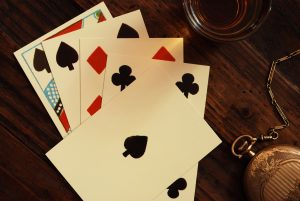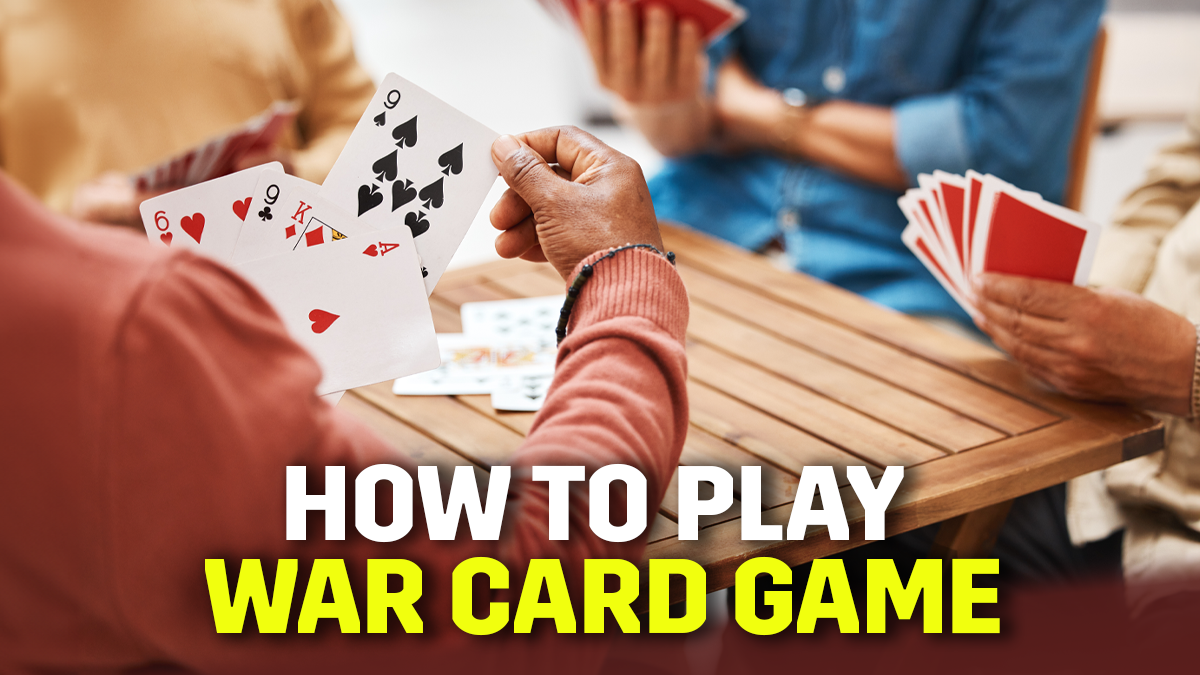Table of Contents
ToggleWar, also known as Battle, is a traditional game played using a standard deck of playing cards. Usually played by children, this is a perfect game for those trying to dip their toes in card games and want to get a hold of the standard deck.
While the rules of war are extremely simple, you need to keep your focus on the game so you don’t miss out on lucrative opportunities. It is also an ideal card game if you are looking to pass the time without indulging in anything complicated.
So, are you ready to get started? In this article, we walk you through the rules of the game and tell you how to play a War card game effortlessly. Let’s dive in!
What is War Card Game?

Source: Marie C Fields /shutterstock
War is a card game played between two players, using a regular deck. Players flip cards simultaneously, and the one with the higher card wins both. The rules of the game are very simple and easy to understand.
However, the War card game’s history is a bit unclear. Nobody knows exactly how it came into existence. But, its popularity in the United States rose around the mid-20th century, especially among kids. Its appeal lies in its simplicity because all you need is a standard deck of cards.
As the game spread, people added their twists and variations, making it flexible and informal. Its lack of a known origin or inventor adds to its charm.
Read More : Top Single-Player Card Games to Play
How To Play War Card Game: War Card Game Rules
Let’s take a look at how to play war including the war card game rules and some strategies to defeat your opponents.
Cards Ranking in War Game
In the War card games, the ranking of cards is pretty straightforward. Usually, the Ace is the highest-ranking card, and the 2 is the lowest. The order typically Ace, King, Queen, Jack, 10, 9, 8, 7, 6, 5, 4, 3, and 2. However, always check the rules of the War game variation you are playing to be on the safe side.
The Objective
The objective of the game is simple – win all 52 cards.
The Deal
In the War card game, the deck of 52 cards is divided equally between the two players, resulting in each player having a stack of 26 cards. The cards are dealt one at a time, face down. The dealing process continues until each player has their respective stack of cards. All are kept face down.
The Play
Once the game begins, players simultaneously reveal the top card from their stacks and put it face up. The player with the higher-ranked card wins both face-up cards. For instance, if you place a 2 and the other player has a 6, they win both face-up cards.
If the cards are of the same rank, a ‘War’ is declared. Each player then places one of the cards face down and one card face up. The player with the higher card face-up takes all cards from the opponent’s face-up pile.
However, if again there’s another tie, the process repeats, with additional cards placed face down and then face up until one player has a higher card face-up, winning all the cards involved in that war. Then, you continue playing until there is a winner.
Scoring
There is no scoring system in the war game. It ends when one player has all the cards.
Can more than 2 players play war?
While war card games are typically played with 2 players, they can also accommodate 3 to 4 players.
All you have to do is ensure that everyone has an equal number of cards. For example, with three players, each receives 17 cards face down, and with four players, each gets 13 cards face down.
The rules of the game, however, remain the same. In case of ties for the highest card, a war is initiated. Here, all players involved in the tie place their next card face-down, followed by turning up a third card. This process continues until one player’s face-up card is higher than the others.
Also, all players participate in a war, not just those with the highest cards. A player who runs out of cards is eliminated.
Read More: A Quick Guide On Dos Card Game Rules and Setup
Variations of War Card Game
Now, let’s take a look at some of the popular variations of the war game.
Steal War
In Steal War, you also include jokers while playing the game. This adds an interesting twist because they are designated as the highest-ranking cards. They surpass all other cards in the deck. When a Joker is played, it automatically beats any other card.
Gary Philippy and Hayes Ruberti developed this game, which blends traditional War and Stealth Bundles. It preserves the classic war format with three face-down cards and one face-up card. The inclusion of high-value Jokers introduces a dynamic twist to gameplay.
Unlike the traditional War, won cards don’t return under the deck but form a separate face-up pile. This gives you room to make strategic decisions. Winners decide the order of newly won cards.
Players can also inspect face-down cards before playing. If a card matches the opponent’s top face-up card, a steal opportunity arises. Placing the card on the opponent’s pile lets you claim it, reshuffling the combined decks without changing the order. However, once a card is played, the chance to steal is forfeited.
Players may choose between playing for potential war victories or strategic stealing, especially in multiplayer games, where one card can match multiple opponents’ decks.
During wars, the face-down cards remain hidden, but the fourth card can be used for stealing. If the face-down pile depletes, the face-up pile shuffles for continued gameplay. Running out of cards during War results in automatic defeat.
Additional Read: Best 3-Player Card Games
Tod und Leben (Life and Death)
Günther Senst’s childhood card game, played in Mecklenburg, Germany, is a unique variant of war card games.
So, what are the war card game rules here? Well, the deck is played through once without recycling cards. Using a 32-card pack with ranks A – K – Q – J – 10 – 9 – 8 – 7 and disregarding suits, each player receives 16 cards face down.
Players simultaneously reveal their top card, and the one with the higher card takes the trick. It means they store the cards face down without recycling them.
If the cards are the same rank, players turn the next card face up, extending the trick to 4 cards and so on. In case of equality in the final cards, each player adds their played card to their tricks.
After all 16 cards are played, the player with more won cards wins the round. The game can continue for as many rounds as desired. It offers a simple yet intriguing variation of the traditional War card game.
Peace
Here, the rules flip from the traditional War game. Instead of the highest card, the lowest card always wins. When two players lay down their cards, the one with the lowest rank takes both cards. If there’s a tie, just like in War, each player lays down more cards to break it. Peace is a fun twist when it comes to game of war card game!
P’yanitsa (Drunkard)
The Russian version of War is known as P’yanitsa or Drunkurd. It is played by 2 players, occasionally expanding to 3 or 4. The deck comprises 36 cards, featuring A-K-Q-J-10-9-8-7-6 in each suit. So, how to play war, the Russian version? Players choose between two versions.
In the first one, you avoid collecting all cards, or in the second, you choose not to run out of cards. The deal involves distributing all cards face down evenly. Each trick unfolds as players simultaneously reveal their top card.
The highest rank secures the win. Like in the traditional war game, the card ranking is A, K, Q, J, 10, 9, 8, 7, and 6. However, there is a peculiar rule where six beats an ace.
When there is a tie, you must keep additional face-up or face-down cards. The winner is determined by the highest new face-up card. The game concludes either with the player left holding all cards as the loser or the first to deplete their cards declared the loser.
Syrian War
In this variant, two players take turns rather than playing simultaneously. The deck uses a non-standard ranking, with the Ace as the lowest card (below the 2) and the King as the highest. Players alternately turn over the top card of their packet, adding it to the face-up play pile.
If the played card is lower or the play pile is empty, nothing happens, and the next player takes their turn. If the played card is higher, the player captures the entire play pile, turns it over, and adds it to the bottom of their face-down packet. If the cards are the same rank, a war is declared.
During a war, players play several cards based on the rank that caused the war. If a player lacks cards, they play all they have, and their opponent matches the number. The player with the higher last card in the war captures both rows but not the play pile. The game ends when one player is left with no cards. This is how to play war game.
Automatic War
In Automatic War, whenever a player lays down a card with the rank of two, a War is instantly triggered. This means that both players must place another card face down, followed by one more card face up. The highest face-up card wins all the cards from the round. If another two are laid down during this process, the War continues. The game keeps going like this until one player has all the cards. Automatic War is a game of war card game that adds excitement because the two cards, though low in rank, can actually change the flow of the game very quickly.
Additional Read: Popular Card Games For Every Occasion
FAQs
Can you play War with 3 players?
Yes, War can be played with 3 players. In a 3-player game, each player receives roughly one-third of the deck. For instance, 52 cards get distributed equally among 3 players.
What is the goal of the game War Cards?
The goal of War Cards is to win all the cards in the deck. You take turns with other players drawing cards. Then, the one with the highest card wins that round. The game continues until one player collects all the cards and they are declared the winner.
What is the highest in the War card game?
In War, the highest card is the ace. It beats all other cards. So, to put it simply, it is the strongest card in the game. If two aces are played at the same time, a War is triggered, where more cards are drawn to decide the winner.
Is the War card game all luck?
The War card game involves luck as it relies on randomly drawn cards. While strategy can be applied during a ‘war,’ the game’s simplicity means chance plays a significant role. However, there are other variants of the war game where strategy plays a main role.
What is the best card in War?
In War, there the highest cards are the best cards. That said, there isn’t a single best card. The outcome depends on the drawn cards.
How do you play War cards game?
To play War, shuffle and deal the entire deck among players. Next, each player will flip the top card face-up. The one with the highest card wins both cards. The game continues till one player wins all the cards.
What deck do you use to play War card games?
A standard 52-card deck is commonly used for War card games, excluding jokers. However, some variants of war games, like Steal War use jokers.
What is a double war in a war game?
A double war in war card games occurs when there is a tie during a war. This occurs when both players flip a card of the same rank face up, and the subsequent round of face-down and face-up cards also results in a tie. This leads to an extended war, with more cards being added to the pile of face down and face up before declaring the winner. The winner gets all the cards face up.
How many same-rank cards are there in a deck?
In a standard 52-card deck, there are 4 cards of each rank. So, there are four same-rank cards for each of the 13 ranks. For instance, there are 4 Aces, 4 Kings, and so on.
In war, should you play your card face up?
Yes, in the traditional War game, players typically play the card face up.








